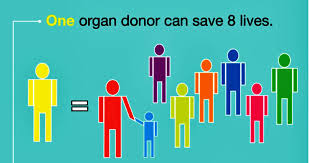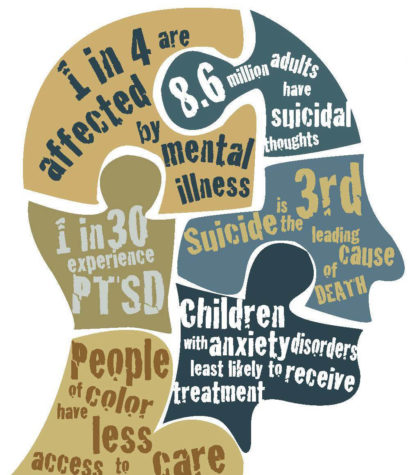Organ Donation

“To the world you may be one person; but to one person you may be the world.” -Dr. Seuss. Although this is a quote from Dr. Seuss, it can relate a lot to organ donation. With organ donation, one person’s death can end up saving multiple people’s lives. The amount of people waiting for organs is always increasing, and as a result the demand for donors is increasing as well. Organ donation is crucial in saving the lives of people suffering from disease and illness. The importance and benefits of organ donation will be explained with an overview of how to become an organ donor, common health issues associated requiring organ donation, the statistics of today’s donors, and what controversy surrounds organ donation.
Organ donation is the process of transplanting organs from a donor to someone in need. Organ donation has saved countless lives throughout the years, but before organ donation was possible, many people suffering from illnesses often didn’t survive. Now it is possible to save these people with a deceased, or in some cases living, organ donor. The most common problem with organ donation today is the lack thereof. According to Dr. Kenneth P. Moritsugu, who was Acting Surgeon General of the United States in 2002 and again in 2006, there were almost 118,000 people waiting for an organ transplant in the United States in 2013. The following infographic by the Organ Procurement & Transplantation Network, an organization run the U.S. Department of Health & Human Services, shows the major gap between the number of people waiting for a transplant and the actual amount of transplants performed. These people are waiting for an organ transplant in order to live healthier, more enjoyable lives. Many of these people are waiting because they can’t find a compatible organ, while others are just waiting for an organ to become available. The simple process to become an organ donor can usually be done at your local Department of Motor Vehicles, or DMV. While filling out the paperwork to get your license, you can fill out the form to become a donor. This quick and easy process is used to encourage more people to become donors. Along with making the process quicker, there is a new policy being adopted in certain countries that increases the number of organ donors. According to Peter Walker, a political correspondent for the Guardian, Wales has already adopted the presumed consent policy for organ donation. The presumed consent policy means that citizens will have to opt-out of being a donor and are otherwise presumed a donor. This new policy, if adopted in the United States, would greatly improve the number of organ donors. A problem with our our policy on organ donation is that people have to take time to register, where this new policy would eliminate that extra work. Another reason for people not donating their organs is because they think they are too old or not healthy enough. However, according to Finger Lakes Donor Recovery Network, a non-profit organ donation program, “Virtually anyone can become a donor. Your medical condition at the time of death will determine what organs and tissues can be donated can be donated for transplant or scientific research”. People should not base their decision to become an organ donor off of their age or health, as the doctors will determine if you are eligible to donate when the time comes. Even if you think you are too old to donate, your organs might still be healthy and end up saving someone’s life. Not only is becoming a donor an easy process, but it can also end up saving people from disease and illness.
The use of organ donation can end up saving the lives of people with diseases or illnesses that were previously incurable. Susan Scutti, a medical journalist, stated that, “In 2016, a total of 19,057 kidney transplants occurred, followed by 7,841 liver transplants, 3,191 heart transplants and 2,327 lung transplants.”. Before organ donation, a failing organ was often a death sentence, as there was no way to cure it. However, modern medicine has made previously unthinkable surgeries, like a heart transplant, possible. These surgeries end up saving or improving the lives of many people, such as someone needing a new liver or kidneys. According to the National Kidney Foundation, an organization specializing in kidney disease, “30 million American adults have CKD [chronic kidney disease] and millions of others are at increased risk.” Before organ transplants, people with severe kidney disease would most likely die, but now, kidney transplants have become the most common transplant. Replacing the failing kidney early enough can stop it from causing other diseases, like heart disease. Other transplants that were previously very dangerous are now more common. According to the Western Cape Government, the government of the Western Cape in South Africa,
Groote Schuur Hospital was placed centre stage in the world’s spotlight when Professor Christiaan Barnard performed the first human heart transplant on the third of December 1967. Sadly, Mr Louis Washkansky (pictured left) only lived for 18 days, succumbing in the end to pneumonia. His new heart beat strongly to the end.
Medicine has since greatly improved, making heart transplants safer than before. As stated by the Mayo Clinic, “The overall survival rate in the U.S. is about 88 percent after one year.” Organ donation and transplantation makes it possible for these people to survive and enjoy life, just like the rest of us. As a result of organ donation becoming so common, the demand for organs has skyrocketed.
The amount of people waiting for an organ transplant increases every day, but luckily there has been a rise in the number of donors. Susan Scutti, a journalist writing about medical issues for Newsweek, CNN, CBS Philly, and Medical Daily, said, “During 2016, there were 33,606 transplants, an 8.5% increase over 2015 and up 19.8% since 2012” The higher number of transplants means more lives were saved and less people died while waiting for an organ. Due to multiple reasons, the United States saw an increase in donors in 2016. When interviewed by Susan Scutti, Alexandra Glazier, president and CEO of the New England Organ Bank, stated, “We achieved a 19% increase in organ donation” This increase can be attributed to many different causes, such as an increase in drug overdoses, but ends up saving more people’s lives. The wait list for organs is growing like the nation’s debt, and it will continue to do so if more people do not become organ donors. Although not everybody wants to or feels comfortable with donating their organs, a main reason why the number of donors increased is because drug overdoses increased as well. During an interview with Susan Scutti, Dr. David Klassen, chief medical officer of the organ sharing network, stated that, “The percentage of donors who have died from overdoses is approaching 25% of the donor population in some parts of the country”. Drug overdose is not something to celebrate; however, the people who have had a fatal overdose can end up saving multiple lives. This can be a comforting thought to the families of the people who overdosed, knowing that they can still end up greatly affecting someone’s life for the better. The demand for donors has increased, therefore requiring more people to become eligible to donate that were previously unable to.
Organ donation is extremely beneficial in saving people’s lives and helping them recover; however, there is some controversy with it. To increase the number of donors, people who are brain dead, meaning their brain no longer functions and has no consciousness, can be used as donors if their family gives consent. The controversy with this method is that brain dead patients are not completely dead, as their heart is still beating with help from life support systems. Therefore, life support has to be stopped before their organs can be removed for donation. However, there are laws in place making sure the patients are truly brain dead and there is no possibility of recovery. According to Dr. Robert M. Sade, the Uniform Determination of Death Act, or UDDA, was enacted in 1981 to clarify when a patient was considered legally dead and could then be used as an organ donor. The UDDA is used along with the Dead Donor Rule, or DDR, stating that removing organs from a patient in order to donate them can not cause death. This means that the patient must already be brain dead and legally considered dead before they can donate organs; as a result, these laws make using brain dead patients as organ donors as ethical as possible. As stated by the UDDA,
An individual who has sustained either (1) irreversible cessation of circulatory and respiratory functions, or (2) irreversible cessation of all functions of the entire brain, including the brain stem, is dead. A determination of death must be made in accordance with accepted medical standards (Sade).
This law makes sure that brain dead patients meet these criteria before being declared legally dead, eliminating the chance for somebody with the possibility of recovering to be used as a donor. It would seem like a brain dead patient is still alive because they are breathing and their heart is beating, but brain death means that all brain activity has stopped and all parts of a person’s consciousness have gone. Without brain function, a person’s body cannot continue to survive. Finger Lakes Donor Recovery Network, a non-profit organ donation organization in New York, explains that removing the life support systems from a brain dead patient is not considered killing them, since the brain is already dead and can not recover. This supports why using brain dead patients as donors is ethical, as there is no possibility for their brain to recover. A patient could rely on life support systems, but the body and organs begin to die immediately after brain death, which soon eliminates the chance of their organs being able to save other lives. Using brain dead patients as donors has greatly increased the number of lives saved by organ donation.
The survival of people suffering from disease and illness is contingent upon organ donation. Without the proper amount of organ donors, countless people die waiting for an organ transplant. Becoming a donor is easy, and can often be done at your local DMV. Organ donation can end up saving people from previously incurable diseases and illnesses, and although the United States has seen an increase in donors, there are still many people waiting for organs. Although there is controversy surrounding using brain dead patients as organ donors, there are laws in place making sure the patient has no chance of recovery and is truly brain dead. Saving the life of multiple people is as easy as heading to the DMV and registering to be an organ donor, which everyone is encouraged to do.
Works Cited
“About Chronic Kidney Disease.” Kidney.org, National Kidney Foundation, Inc.
“Chris Barnard Performs World’s First Heart Transplant.” Westerncape.gov.za, Western Cape Government,
“Heart Transplant.” Mayoclinic.org, Mayo Foundation for Medical Education and Research,
Moritsugu, Kenneth P. “The Power of Organ Donation to Save Lives Through Transplantation.” Ncbi.nlm.nih.gov, National Center for Biotechnology Information, U.S. National Library of Medicine, 2013,
“Organ Donation Facts.” Liveonny.org, LiveOnNY, Inc,
“Organ Procurement and Transplantation Network.” Optn.transplant.hrsa.gov, U.S. Department of Health & Human Services, optn.transplant.hrsa.gov/.
Scutti, Susan. “US Organ Transplants Increased Nearly 20% in Five Years.” Cnn.com, Cable News Network, 9 Jan. 2017,
Spade, Robert M. “BRAIN DEATH, CARDIAC DEATH, AND THE DEAD DONOR RULE.” Ncbi.nlm.nih.gov, National Center for Biotechnology Information, U.S. National Library of Medicine, Aug. 2011,
“Understanding Brain Death.” Donorrecovery.org, Finger Lakes Donor Recovery Network,
Walker, Peter. “Organ Donation Presumed Consent Could Be Adopted in England.” Theguardian.com, Guardian News and Media Limited, 30 June 2017.






